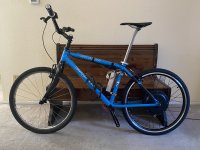I hope this is in the right place, please move if not. And wow there is a wealth of knowledge here but forgive me I'm still lost and looking for specific input here.
I'm looking to convert one of my old mountain bikes to an e-bike. Typically 68mm bb, 135mm dropouts. I would like to do a smaller diameter rear hub motor and ideally still get a little oomph off the line. This would be a fun bike for zipping around. I (200lb, 6ft) currently have a knee injury so need to be able to get going without much pedaling. I do plan on recovering and would like to be able to do 30-32mph with pedaling hard. I can play with gearing to get a gear that I can pedal that high. I wanted regen braking as I enjoy it in my vehicle but I've let that go given my budget.
For power/price I was targeting 1500W at 52V, though I'm seeing this may not be the best metric to meet my goals. In early searches (I started this last year) seems to me I could get a cheap kit for low $200 (AliX, etc) and then batteries start at around $200, so $400 total. However, I'm reading these direct drive hubmotors will not provide much torque off the line and generally people are recommending to get higher quality components.
I came across this kit from calibike and appreciated the compactness of the rear hub but upon further inspection it seems it may not actually be a 1500W setup. It doesn't say that anywhere but it just seems like all motors that size offered elsewhere are lower wattage. And if I'm getting a lower wattage setup, I could probably pay less.
Is this a good kit or will I be disappointed? This is more than I initially wanted to spend but if it was really a compact motor that put out 1500W and got up to 37 MPH I could potentially push the budget. Even if that were true, I'd imagine the acceleration would be poor given what I'm reading.
Say I am willing to spend about $375 on the kit. What are some great options available now or maybe soon if out of stock given my goals?
Also not opposed to buying a used kit so save $ if available. It's likely this be ridden hard and infrequently, and not needed for commuter reliability
Thanks for your consideration
I'm looking to convert one of my old mountain bikes to an e-bike. Typically 68mm bb, 135mm dropouts. I would like to do a smaller diameter rear hub motor and ideally still get a little oomph off the line. This would be a fun bike for zipping around. I (200lb, 6ft) currently have a knee injury so need to be able to get going without much pedaling. I do plan on recovering and would like to be able to do 30-32mph with pedaling hard. I can play with gearing to get a gear that I can pedal that high. I wanted regen braking as I enjoy it in my vehicle but I've let that go given my budget.
For power/price I was targeting 1500W at 52V, though I'm seeing this may not be the best metric to meet my goals. In early searches (I started this last year) seems to me I could get a cheap kit for low $200 (AliX, etc) and then batteries start at around $200, so $400 total. However, I'm reading these direct drive hubmotors will not provide much torque off the line and generally people are recommending to get higher quality components.
I came across this kit from calibike and appreciated the compactness of the rear hub but upon further inspection it seems it may not actually be a 1500W setup. It doesn't say that anywhere but it just seems like all motors that size offered elsewhere are lower wattage. And if I'm getting a lower wattage setup, I could probably pay less.
Is this a good kit or will I be disappointed? This is more than I initially wanted to spend but if it was really a compact motor that put out 1500W and got up to 37 MPH I could potentially push the budget. Even if that were true, I'd imagine the acceleration would be poor given what I'm reading.
Say I am willing to spend about $375 on the kit. What are some great options available now or maybe soon if out of stock given my goals?
Also not opposed to buying a used kit so save $ if available. It's likely this be ridden hard and infrequently, and not needed for commuter reliability
Thanks for your consideration
Last edited:



